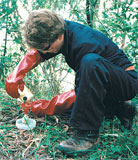Many of the weed control techniques suggested on this and the following pages involve the use of herbicides. Herbicides are poisons, and should be handled with the greatest respect. They can be absorbed very easily through the skin, by breathing the vapours, and by ingestion (eating or drinking).
Always read the herbicide label to ensure the product is registered for the proposed purpose. By law, herbicides must be used strictly in accordance with the manufacturer's label. The label provides detailed instructions on the use, application, storage, personal protective equipment requirements, first aid and disposal methods required. They should be kept well out of the reach of children, preferably secured in a locked cabinet. They should always be stored in the original labelled container.
USE OF HERBICIDE: SAFETY PRECAUTIONS
- Read the label before opening the container and follow the instructions.
- Wear protective clothing: long sleeves, long pants, sturdy shoes, gloves, eye protection.
- Always wear waterproof gloves. A respirator is advised when mixing or pouring the liquid.
- Do not eat, drink or smoke while using herbicide. Keep children and pets away.
- Wash skin and equipment afterwards. Wash contaminated clothing separately.
- Clean up any spills according to manufacturers label instructions.
Types of herbicide
There are two widely used herbicides licensed for use at home:
Glyphosate, sold under various trade names, including Roundup® and Zero® (which have different concentrations), and Triclopyr, sold as Tree, Blackberry and Woody Weed Killer (etc.).
How herbicides work
Glyphosate is a systemic, non-selective herbicide. It inhibits the action of an enzyme, preventing the production of an amino acid essential to plant life and growth. It must be applied to green leaves, or directly to the plant’s sapwood, which lies under the bark.
Triclopyr is a selective systemic herbicide for woody and broadleaf plants. It is a growth inhibitor which moves to the plant's roots, stops growth, and eventually leads to the death of the plant. Triclopyr can be applied to green leaves and to bark.
Herbicides, waterways and steep land
Some of the chemicals which are added to herbicides are not safe to use near waterways. They have the potential to seriously affect the quality of aquatic ecosystems. If you need to remove weeds, particularly trees, within 20 m of any kind of watercourse, even a drain that runs only when it is raining, you should seek advice and assistance from your local council's environmental management department or Natural Resource Management Board.